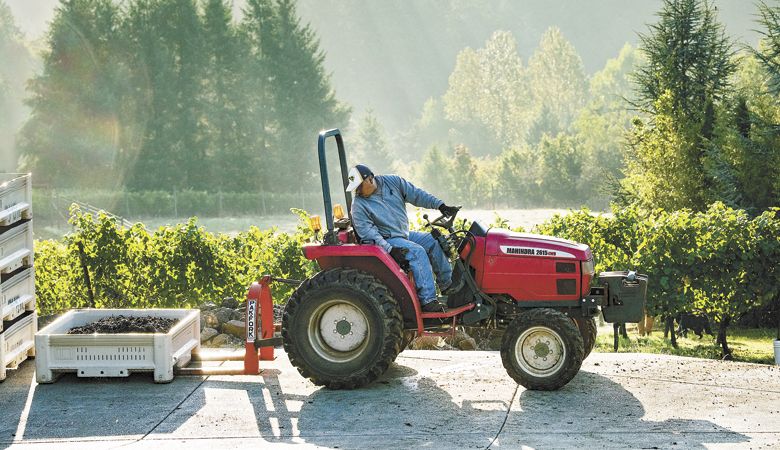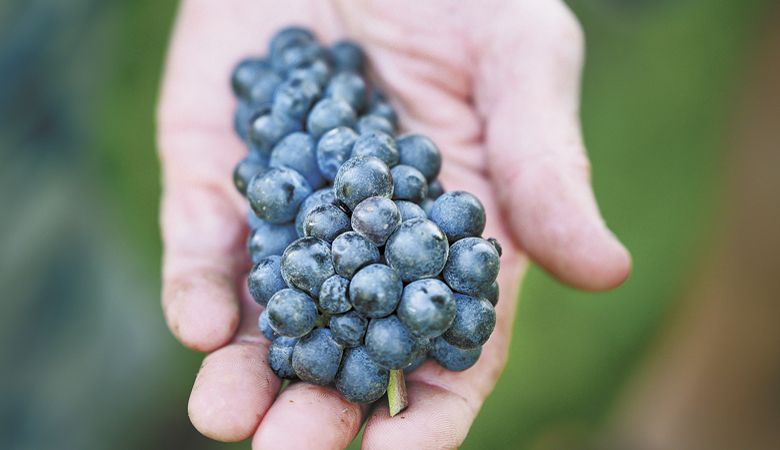Take Your Pick
Willamette Valley winemakers weigh in on harvest strategies
Some questions don’t have definitive answers, but we ask them anyway. The best time to pick grapes is one of those queries. How a winemaker chooses to answer that question affects their entire harvest. If picked too early, tannins may be green, bitter and underdeveloped. Picked too late, and the risk for rain, hail, pests, rot and other catastrophes may compromise the wine or entire vintage.
Ask winemakers how they decide the best time to harvest their grapes, and you’ll likely get varying answers, depending on variety — some ripen early, others later — region, elevation or the style of wine.
Data-driven winemakers look strictly at the numbers, specifically Brix and pH. Brix, the measurement of sugar in grapes, helps determine alcohol levels, while pH represents the degree of relative acidity vs. the degree of relative alkalinity. Winemakers use pH to measure ripeness in relation to acidity; low pH wines taste tart and crisp; higher pH wines are susceptible to bacterial growth.
Overall, winemakers don’t rely on any single factor to determine the ideal pick time, preferring a combination of considerations. Gran Moraine winemaker Shane Moore takes a different approach. He picks when the grapes “stop talking to the leaves.” This may sound like ju-ju, but it actually makes perfect sense.
Ariel Eberle, Yamhill Valley Vineyards’ winemaker, supports Moore’s approach. She explains how Stephen Cary, long-time winemaker at Yamhill Valley Vineyards, taught her to look to the vines when making such choices. He was so committed to this that his headstone, which rests at Yamhill Valley Vineyards says, “We didn’t tell them (the vines), they told us.”
According to Eberle, “It illustrates that a good winegrower is connected with their place. They not only take walks in the vineyard to observe tastes, textures, flavors and ripeness, they also look for small phenological signs from the vines such as leaves turning yellow — a sign of senescence that tells the winegrower that the vines’ ability to accumulate sugars is petering out.” She watches for browning seeds, a fleshy pulp — varietal dependent — and chewy skins as ripeness increases. Allan Johnson, winemaker at Palliser Estate in Martinborough, New Zealand, taught Eberle to look for black tea qualities in Pinot Noir skins as the fruit enters the next stage of ripeness.
And yet, she doesn’t discount the chemistry. Yamhill Valley Vineyards blindly collects samples from each section because, as Eberle explains, “Our human minds tend to go for the juicier-looking clusters; sampling blind removes that instinctual habit that can skew numbers to give false positives on ripeness.” Those samples are treated as closely as possible to how they will be treated when the blocks of grapes are brought in at harvest, intentionally simulating their experience in order to make the most accurate picking decision possible. Pinot Noir is crushed and then soaks in its sample bag for an hour or more — depending on how many dehydrated grapes might be re-hydrated — to acquire a more accurate Brix and pH reading — high levels of potassium can shift a pH upwards during the cold soak and/or fermentation.
Eberle points out, “All of what I previously spoke about is only accounting for perfect conditions. We also have to consider outside influences like rain, birds, availability of pickers, safety precautions — tractors on slippery hillsides hauling tons of grapes is very risky — insect damage and so on. A winemaker’s best bet is to take the approach of ‘best possible outcome,’ while realistically considering all of the risks and benefits.”
Cyler Varnum, owner/winemaker of Varnum Vintners, also relies on multiple factors. “We most commonly test brix, but we also always check grapes for physiological development (seed and sack) and phenolic development (flavors and tannin impression on the palate).”
Varnum stresses the importance of listening to other growers and producers, making it a point to visit several vineyards and wineries each year. In talking to multiple growers, winemakers and managers, he’s able to sense trends in their cumulative thoughts on the vintage. “For example, this year we deduced that while grape sugars are roughly 1 to 2 brix behind last year, the flavors and acids are roughly just as developed as they were last year.” Picks can be decided based on adjustment of wine style to the vintage. Varnum says that since this vintage is cooler, the grapes are generally lower in sugar and contain slightly higher acid, and will therefore be a great vintage for sparkling wine.
Winemaker Vincent Fritzsche, owner of Vincent Wines, finds pH is the most reliable single data point for ripeness. “Sort of like temperature for cooking meats,” he says. Other things play into it, but pH is critical. For example, if people go only by Brix, then 23 Brix would say to pick. But if it’s Pinot Noir and the pH is only 3.1, he might think, “Hold on, that’s still too low.” However, if the pH were 3.25 and the brix only 21, he’d be more inclined to pick.
Of course, Fritzsche also tastes the fruit, skins, seeds, etc., and he touches the fruit. “You can tell a lot by how it feels — again, like grilling steaks. But once pH gets higher, I think you’ve missed the liveliness and al dente quality I’m looking for. Other winemakers will say, ‘No, wait for flavors and then add acidity back to the juice in the winery.’ To me that’s like burning something, then cutting off the burned parts and saying, ‘There, it’s perfect!’”
And though winemakers may disagree on how and when to get there, they’ll likely agree it’s the sugar-acid-tannin trifecta they’re waiting for. Let the arguments about fermentation begin.












